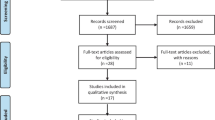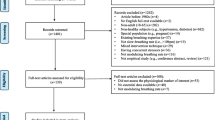Abstract
We evaluated the effects of long-term digoxin therapy on exercise capacity and on physiological parameters reflecting autonomic tone in 23 patients with mild to moderate heart failure. Before and after maintenance digoxin treatment, all patients underwent cardiopulmonary exercise testing and indexes of heart rate variability (HRV) and baroreceptor sensitivity (BRS) were measured. Long-term digoxin therapy significantly (P > 0.05) increased time domain indexes (rMSSD, pNN50) which reflect parasympathetic activity (from 30 ± 16 to 37 ± 14 and from 8 ± 9 to 12 ± 7, respectively). High-frequency (HF) and low-frequency (LF) power spectral components also showed a significant increase (from 4.5 ± 1 to 5.1 ± 1 and from 5.4 ± 1 to 5.8 ± 1, respectively), but the ratio LF/HF decreased, indicating a predominance of vagal activity. The magnitude of these changes exhibited a strong negative Pearson correlation coefficient when compared with initial values before treatment. BRS increased from 2.95 ± 1.2 to 5.32 ± 3 ms/mmHg (P > 0.05). Oxygen consumption at peak exercise and at the anerobic threshold increased significantly (from 17 ± 3 to 19 ± 3 mL/kg/min and from 14.7 ± 3 to 16.5 ± 3 mL/kg/min, respectively). A persistent negative correlation was found between initial values of HRV and the magnitude of changes in exercise capacity. These findings show that long-term digoxin therapy increases vagal activity and improves exercise capacity in patients with mild to moderate heart failure and seems to exert a more marked therapeutic effect on patients with poorer initial autonomic function.
Similar content being viewed by others
References
Packer M. The neurohormonal hypothesis: A theory to explain the mechanism of the disease progression in heart failure. J Am Coll Cardiol 1992;20:248-254.
Swedberg K. Is neurohormonol activation deleterious to the long-term outcome of patients with congestive heart failure? Protagonist's viewpoint. J Am Coll Cardiol 1988;12: 550-554.
Thomas JA, Marks BH. Plasma norepinephine in congestive heart failure. Am J Cardiol 1978;41:233-243.
Eckberg DL, Drabinsky M, Braunwald E. Defective cardiac parasympathetic control in patients with heart disease. N Engl J Med 1971;285:877-883.
Binkley PF, Nunziata E, Haas GJ, Nelson SD, Cody RJ. Parasympathetic withdrawal is an integral component of autonomic imbalance in congestive heart failure: Demonstration in human subjects and verification in a paced canine model of ventricular failure. J Am Coll Cardiol 1991;18: 464-472.
The Captopril-Digoxin Multicenter Research Group. Comparative effects of therapy with captopril and digoxin in patients with mild to moderate heart failure. JAMA 1988; 259:539-544.
Di Bianco R, Shabetai R, Kostuk W, Moran J, Schlant RC, Wright R, for the Milrinore Multicenter Trial Group. A comparison of oral milrinore, digoxin and their combination in the treatment of patients with chronic heart failure. N Engl J Med 1989;320:677-683.
Ferguson DW, Berg WJ, Sanders JS, Roach PJ, Kempf JS, Kienzle MG. Sympathoinhibitory responses to digitalis glycosides in heart failure patients. Direct evidence from sympathetic neural recordings. Circulation 1989;80:65-77.
Georghiade M, Ferguson D. Digoxin. A neurohormonal modulator in heart failure. Circulation 1991;84:2181-2186.
Van Veldhuisen DJ, Man in't Veld AJ, Dunselman PHJM, et al. Double blind placebo-controlled study of ibopamine and digoxin in patients with mild to moderate heart failure: Result of the Dutch Ibopamine-Multicenter Trial (DIMT). J Am Coll Cardiol 1993;22:1564-1573.
Sullivan M, Atwood E, Myers J, et al. Increased exercise capacity after digoxin administration in patients with heart failure. J Am Coll Cardiol 1989;13:1138-1143.
Fleg JL, Rothfeld B, Gottlieb SH, Wright J. Effect of maintenance digoxin therapy on aerobic performance and exercise left ventricular function in mild to moderate heart failure due to coronary artery disease. A randomized placebo-controlled crossover trial. J Am Coll Cardiol 1991; 17:743-751.
Krum H, Bigger JT, Goldsmith RL, Packer M. Effect of long term digoxin therapy on autonomic function in patients with chronic heart failure. J Am Coll Cardiol 1995;25:289-294.
Brouwer J, van Veld Huisen DJ, Man in't Veld AJ, Dunselman PH, Boomsma F, Haaksma J, Lie Kl. Heart rate variability in patients with mild to moderate heart failure: Effects of neurohormonal modulation by digoxin and ibopamine. J Am Coll Cardiol 1995;26:983-990.
Cohen-Solal A, Aupetit JF, Gueret P, Kolsky H, Zannad F on behalf of the VO2, French Study Group. Can anaerobic threshold be used as an end-point for therapeutic trial in heart failure? Lessons from a multicenter randomized placebo-controlled trial. Eur Heart J 1994;15:236-241.
Task Force of the European Society of Cardiology and the North American Society of Pacing and Electrophysiology. Heart rate variability: Standards of measurement, physiological interpretation and clinical use. Circulation 1996; 93:1043-1065
Pomeranz B, Macaulay RJB, Caudill MA, et al. Assessment of autonomic function in humans by heart rate spectral analysis. Am J Physiol 1985;248:H151-H153.
Pagani M, Lombardi F, Guzzetti S, et al. Power spectral analysis of heart rate and arterial pressure variabilities as a marker of sympatho-vagal interaction in man and conscious dog. Circ Res 1986;59:178-193.
Malliani A, Lombardi F, Pagani M. Power spectrum analysis of heart rate variability: A tool to explore neural regulatory mechanisms. Br Heart J 1994;71:1-2.
Akselrod S, Gordon D, Ubel FA, et al. Power spectrum analysis of heart rate fluctuation: A quantitative probe of beat-to-beat cardiovascular control. Science 1981;213: 220-222.
Vanoli E, La Rovere MT, Mortara A, Schwartz PJ. Methods for assessment of vagal reflexes. In: Levy MN, Scwartz PJ, eds. Vagal Control of the Heart. Experimental Basis and Clinical Implications. Armonk NY. Futura, 1994:455-480.
Katz S, Mancini D, Jondeau G. Physiological determinants of maximal and submaximal exercise capacity in normal subjects and patients with heart failure. Heart Failure 1995;11: 236-242.
Stein PK, Rich MW, Rottman JN, Kleiger RE. Stability of index of heart rate variability in patients with congestive heart failure. Am Heart J 1995;129:975-981.
Rottman JN, Steinman RC, Albrecht P, Bigger JT, Rolnitzky LM, Fleiss JL. Efficient estimation of the heart period power spectrum suitable for physiologic or pharmacologic studies. Am J Cardiol 1990;66:1522-1524.
Ellen bogen KA, Mohanty PK, Szentperety S, Thames MD. Arterial baroreflex abnormalities in heart failure. Reversal after orthotopic cardiac transplantation. Circulation 1989; 79:51-58.
Ferrari A, Gragorini L, Ferrari MC, Prefi L, Mancia G. Digitalis and baroreceptor reflexes in man. Circulation 1981;63:279-285.
Ferguson DW, Abboud FM, Mark AL. Selective impairment of baroreflex-mediated vasoconstrictor responses in patients with ventricular dysfunction. Circulation 1984;69: 451-460.
Osterziel KJ, Hänlein D, Willenbrock R, Eichhorn C, Luft F, Dietz R. Baroreflex sensitivity and cardiovascular mortality in patients with mild to moderate heart failure. Br Heart J 1995;73:517-522.
Jaeschke R, Oxman AD, Guyatt GH. To what extent do congestive heart failure patients in sinus rhythm benefit from digoxin therapy? A systematic overview and metaanalysis. Am J Med 1990;88:279-286.
Koike A, Itoh H, Taniguchi K, Hiroe M. Detecting abnormalities in left ventricular function during exercise by respiratory measurement. Circulation 1989;80:1737-1746.
Sullivan MJ, Cobb FR. The anaerobic threshold in chronic heart failure. Relation to blood lactate ventrilatory basis, reproducibility and response to exercise training. Circulation 1990;81(Suppl. II):II47-II58.
Katz SD, Berkowitz R, Le Jemtel TH. Anaerobic threshold detection in patients with congestive heart failure. Am J Cardiol 1992;69:1565-1569.
Weber KT, Kinasewitz GT, Janicki JS, Fishman AP. Oxygen utilization and ventilation during exercise in patients with chronic cardiac failure. Circulation 1982;65:1213-1223.
Wilson JR, Fink LI, Ferraro N, Dunkman WB, Jones RA. Use of maximal bicycle exercise testing with respiratory gas analysis to assess exercise performance in patients with congestive heart failure secondary to coronary artery disease or to idiopathic dilated cardiomyopathy. Am J Cardiol 1986;58:601-606.
Francis GS, Rector TS. Maximal exercise tolerance as a therapeutic end point in heart failure. Are we relying on the right measure? Am J Cardiol 1994;73:304-306.
Weber KT, Janick JS. Cardiopulmonary Exercise Testing. Physiologic Principles and Clinical Applications. Philadelphia: WB Saunders, 1986.
Author information
Authors and Affiliations
Rights and permissions
About this article
Cite this article
Vardas, P.E., Kanoupakis, E.M., Kochiadakis, G.E. et al. Effects of Long-Term Digoxin Therapy on Heart Rate Variability, Baroreceptor Sensitivity, and Exercise Capacity in Patients with Heart Failure. Cardiovasc Drugs Ther 12, 47–55 (1998). https://doi.org/10.1023/A:1007785314462
Issue Date:
DOI: https://doi.org/10.1023/A:1007785314462




